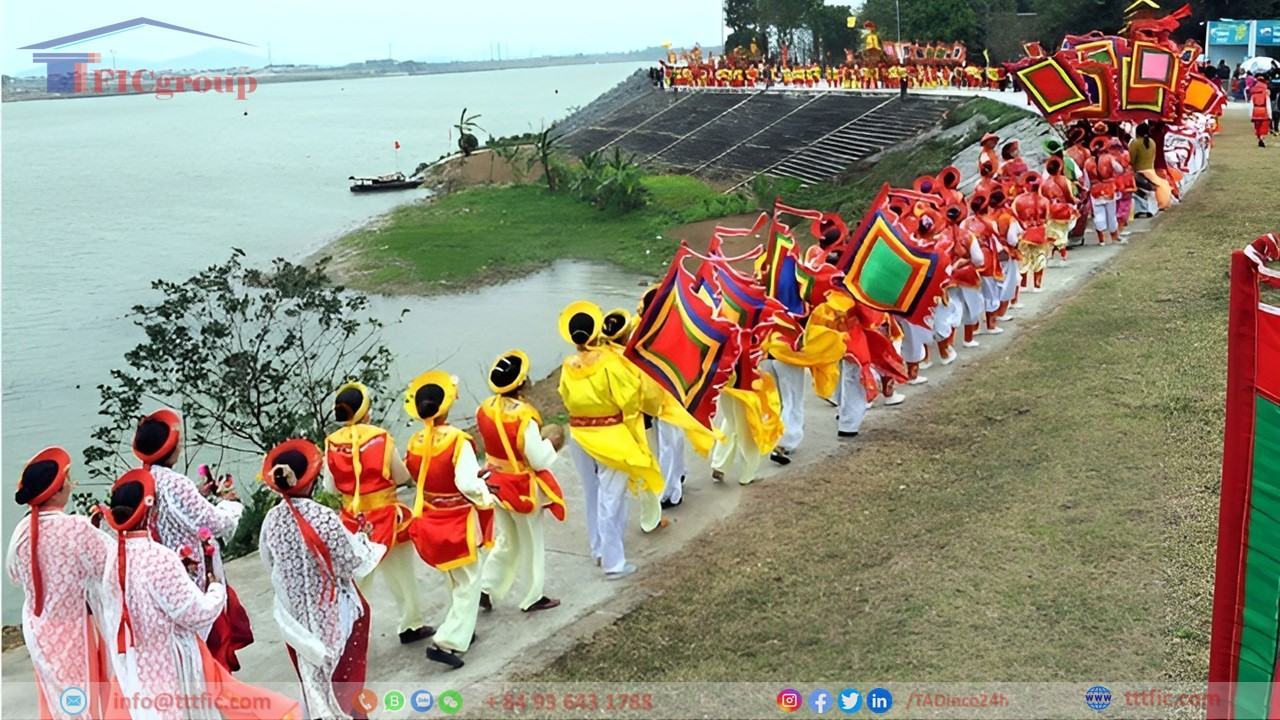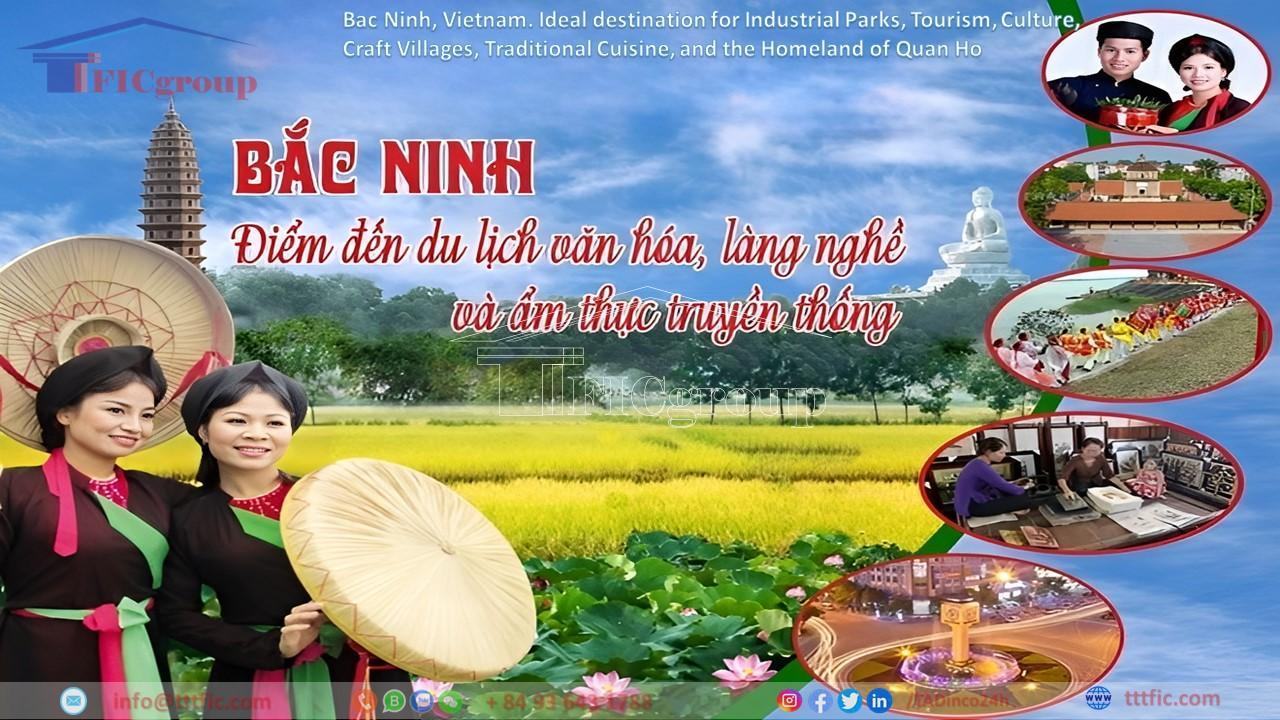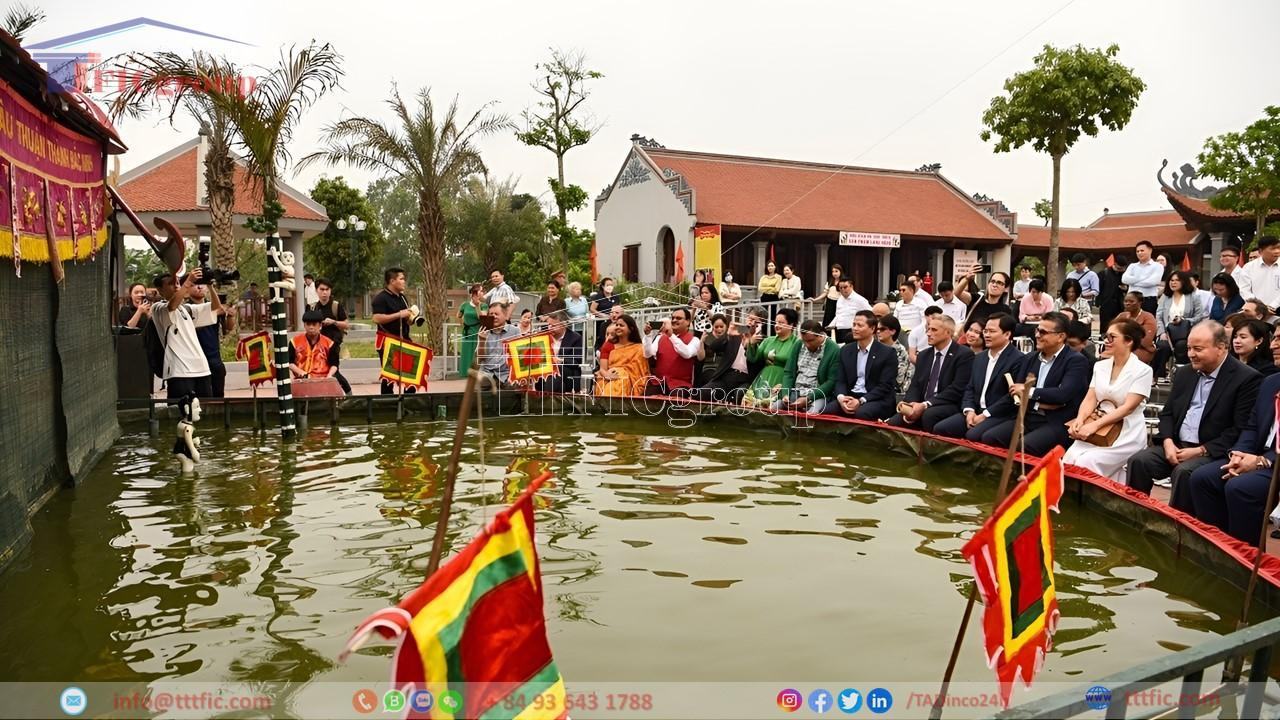Bac Ninh Province:
Bac Ninh province, a province in Vietnam, is the smallest in the country. It is located in the Capital Region of Hanoi, a key economic region in the Northern part of Vietnam, within the Red River Delta. Bắc Ninh was once the center of ancient Kinh Bắc, known for its 44 ancient Quan họ villages, which are recognized as intangible cultural heritage representing humanity, along with Huế royal court music, Tây Nguyên gong culture, and ca trù. The province is also part of the key economic region of Northern Vietnam.

In 2022, Bắc Ninh ranked 22nd in terms of population among administrative units in Vietnam, with a total of 1,488,250 people, including 2 cities, 2 towns, and 4 districts. It ranked eighth in terms of Gross Regional Domestic Product (GRDP) and third in terms of per capita GRDP. The GRDP reached 248,376 billion Vietnamese Dong (equivalent to over 10.8 billion USD), with a per capita GRDP of 7,250 USD (equivalent to 167 million Vietnamese Dong). The GRDP growth rate in 2022 was 7.39%.
Geography of Bac Ninh Province:
Geographical location:
Bắc Ninh borders the northern midland and mountainous region at Bắc Giang province. The city of Bắc Ninh is located 30 km northeast of Hanoi, with the following geographical positions:
- To the East, it borders Hải Dương province.
- To the West, it borders the capital city, Hanoi.
- To the South, it borders Hưng Yên province.
- To the North, it borders Bắc Giang province.
The extreme points of Bắc Ninh province are as follows:
- The westernmost point is in Diên Lộc hamlet, Hòa Tiến commune, Yên Phong district.
- The easternmost point is in Cáp hamlet, Trung Kênh commune, Lương Tài district.
- The northernmost point is in Phù Yên hamlet, Dũng Liệt commune, Yên Phong district.
- The southernmost point is in Ngọc Quan (or Sen) hamlet, Lâm Thao commune, Lương Tài district.
According to the development plan, this province belongs to the Capital Region. Additionally, Bắc Ninh is situated within two economic corridors:
- Côn Minh – Lào Cai – Hanoi – Hải Phòng – Quảng Ninh.
- Nam Ninh – Lạng Sơn – Hanoi – Hải Phòng – Quảng Ninh.
Topography:
The province’s terrain is not entirely flat but rather interspersed with low hills sloping predominantly from North to South and from West to East. This is evident through the surface flow towards the Đuống River and the Thái Bình River. The plain region typically has a common elevation ranging from 3-7 meters, while the midland area (including Quế Võ town and Tiên Du district) features some low hills with heights not exceeding 200 meters. The mountainous area accounts for a small proportion (0.53%) of the total area, mainly located in Quế Võ and Tiên Du.
Hydrology:
Bắc Ninh province is characterized by a dense network of rivers, including the Đuống River, the Cầu River, and the Thái Bình River. These rivers play a significant role in the province’s water resources.
The Đuống River, spanning 42 km within Bắc Ninh, has an average water volume of 31.6 billion m3. It exhibits high sediment content, with 2.8 kg of sediment per 1 m3 of water during the rainy season.
The Cầu River stretches 290 km, with a 70 km section flowing through Bắc Ninh. It annually carries around 5 billion m3 of water, experiencing high water levels during the flood season.
The Thái Bình River, 385 km in length, flows through Bắc Ninh for 17 km. Originating from eroded hilly regions, it has a high sediment concentration and is prone to sedimentation.
Additionally, Bắc Ninh is home to various inland river systems, such as the Ngũ huyện Khê River, Dâu River, and Đông Côi River, among others.
These rivers, along with abundant surface water and significant groundwater reserves, provide essential water resources for the province’s production and daily activities. Effective water management is crucial for the province’s water drainage system and urban areas’ development.

Climate:
Bắc Ninh province is located in a humid subtropical climate zone, experiencing distinct four seasons: spring, summer, autumn, and winter. There is a noticeable temperature difference between hot and humid summers and cold and dry winters, with a range of 15-16 °C.
The rainy season lasts from May to September annually, accounting for 80% of the total annual rainfall.
- The average annual rainfall ranges from 1,400 to 1,700 mm.
- The average temperature is 23.3 °C, and the province receives 1,530-1,776 hours of sunshine per year.
- The average relative humidity is 79%.
Economy of Bac Giang Province:
1997 – 2010:
In 1997, when the province was reestablished, Bac Ninh had an agricultural sector accounting for 45.1%, services 31.1%, and industry-construction 23.8%. The budget revenue was 164 billion VND, with a GDP per capita of 144 USD. The infrastructure was weak, and the industrial sector mainly consisted of small-scale production, reaching a production value of 569 billion VND. Since then, Bac Ninh’s economy has developed significantly.
During the period of 2006-2010, the province experienced an average GDP growth rate of 15.3%, with a remarkable growth rate of 17.86% in 2010, the highest ever recorded.
In 2020:
In 2020, despite not meeting the planned growth rate, Bac Ninh achieved positive growth in its Gross Regional Domestic Product (GRDP). The GRDP, based on 2010 constant prices, reached 124.975 trillion VND, an increase of 3.31%. At current prices, it reached 209.227 trillion VND, growing by 4.58%. This outcome reflected the province’s tremendous efforts, particularly in the last four months of the year.
The industrial construction sector achieved a production value of 88.404 trillion VND, maintaining a growth rate of 5.0% (compared to a 0.2% decrease in 2019), contributing 3.5 percentage points to the overall growth. Similarly to the national trend, Bac Ninh’s industry shifted towards high-value-added industries with large-scale export activities.
In the service sector, several market-oriented service industries made significant contributions to the overall growth. Wholesale and retail increased by 2.8%, contributing the most at 0.12 percentage points. Financial, banking, and insurance activities grew by 8.3%, contributing 0.14 percentage points. Real estate business activities increased by 3.9%, contributing 0.049 percentage points. Education and training activities experienced a remarkable growth of 40%, contributing 0.06 percentage points.
Total state budget revenue in 2020 was 30.731 trillion VND, a 1.1% increase compared to 2019. Customs revenue accounted for 6.375 trillion VND, a 5.5% increase, while domestic revenue slightly increased by 0.04%. Customs revenue contributed 20.7% to the total state budget revenue (a 0.9% increase from 2019), and domestic revenue accounted for 79.3%.
Local budget spending amounted to 24.053 trillion VND, a 13% decrease compared to 2019. Investment and development expenditure reached 11.811 trillion VND, a 24.3% increase, while regular expenditure amounted to 8.560 trillion VND, a 2.8% increase.
The total outstanding credit debt at the end of 2020 reached 101.094 trillion VND, a 12.9% increase.
In 2021:
In 2021, Bac Ninh’s economy continued to thrive. The Gross Regional Domestic Product (GRDP) amounted to 227.615 trillion VND. The Industrial Production Index (IIP) increased by 9.67%. The industrial production value, based on 2010 constant prices, reached 1.284.569 trillion VND, and at current prices, it was 1.5 quadrillion VND. The GRDP grew by 8.8% (at current prices) and 6.9% (based on 2010 constant prices). The per capita GRDP stood at 6,738 USD, and the per capita income reached 71.8 million VND. The state budget revenue was
33.052 trillion VND, with domestic revenue accounting for 25.327 trillion VND. The population was 1,462,945, with an urbanization rate of 38%.
Bac Ninh’s exports amounted to 46.408 billion USD, and imports reached 41.260 billion USD. The total capital mobilization in the province was 196.200 trillion VND. The total retail sales of goods and services reached 61.903 trillion VND. There were 2,344 newly established enterprises with a total registered capital of 28.622 trillion VND. The accumulated FDI reached 21.243 billion USD, and domestic investment attracted 27.543 trillion VND. The total investment for development in 2021 was 58.2 trillion VND. All districts met the new rural standards, and the multidimensional poverty rate was 0.85%.
Social:
Residential:
In 2022, the population of Bac Ninh was 1,488,250, accounting for 1.4% of the country’s population and ranking 22nd out of 63 provinces and cities. The male population was 732,045, and the female population was 756,205. The urban area had 763,770 people, representing 51.32% of the total provincial population, while the rural area had 724,480 people, accounting for 48.68%. The population density in Bac Ninh reached 1,809 people/km², nearly five times the national average, making it the third most densely populated locality among the 63 provinces and cities, only behind Hanoi and Ho Chi Minh City.
Bac Ninh had a labor force of 789,420 people, accounting for 53.04% of the total population. As of 2022, 60.34% of the population lived in urban areas (I, III, IV, V) with 898,010 people, and 39.66% lived outside urban areas with 590,240 people. Bac Ninh aims to meet the criteria of a centrally-governed first-class urban area.
The province is home to various ethnic groups, with the Kinh people being the majority. The three most populous ethnic groups are: Kinh (1,021,061 people, 99.67% of the total population), Tày (1,484 people, 0.14% of the total population), and Nùng (789 people, 0.08% of the total population).
Similar to most other provinces in Northern Vietnam, Bac Ninh has a majority of “non-religious” residents. According to statistics in 2019, the number of people following a religion in Bac Ninh was 43,573, accounting for 3.7% of the total population. Currently, Bac Ninh has seven active religions: Buddhism, Catholicism, Protestantism, Islam, Minh Ly Dao, Hoa Hao Buddhism, and Caodaism. There are 40 Catholic parishes operating in Bac Ninh, all under the guidance of the Bac Ninh Diocese.

Relegion:
Here is the breakdown of the religions and their respective followers in Bac Ninh:
- Catholicism: 36,701 followers (2% of the total provincial population)
- Buddhism: 4,844 followers (0.4%)
- Protestantism: 17 followers
- Islam: 5 followers
- Hoa Hao Buddhism: 3 followers
- Caodaism: 2 followers
- Minh Ly Dao: 1 follower
Total: 53,573 followers, accounting for 3.9% of the total population.
Healthcare:
According to the General Statistics Office of Vietnam, in 2010, Bac Ninh had 217 healthcare facilities under the Department of Health, including 19 hospitals, 10 regional clinics, and 186 medical stations. Alongside the state healthcare system, there is also a developing network of private hospitals and clinics. Bac Ninh currently has the following hospitals:
- Bac Ninh General Hospital
- Military Hospital 110
- Traditional Medicine and Rehabilitation Hospital of Bac Ninh Province
- Bac Ninh Mental Health Hospital
- Bac Ninh Dermatology Hospital
- Bac Ninh Pediatric Hospital
- Bac Ninh Eye Hospital
- Bac Ninh Lung Hospital
- Kinh Bac II General Hospital
- Song Cau Eye Hospital
- Hong Phuc General Hospital
- Nga Tu Ho General Hospital
- Health centers in the districts, towns, and cities of the province.
Social welfare
Bac Ninh is one of the leading provinces in the country in terms of social welfare and security policies. Notable policies include support for the elderly aged 65 and above, providing electricity for lighting in villages and neighborhoods, expanding the beneficiaries of the School Milk Program to include first and second-grade students, contributing to improving the people’s living standards. The poverty rate has been decreasing over the years, reaching 2.06% in 2017.
Education:
Throughout history, Bac Ninh has been the province with the most Trang Nguyen (provincial scholars) in Vietnam, despite having the smallest area in the country. The first examination department was the Ming Confucian examination department, and the Nho (Confucian) examination department, known as the orthodox Trang Nguyen, was first established with all candidates coming from Bac Ninh. In the imperial examinations held under feudal dynasties, the nation selected 47 Trang Nguyen and 2,991 Doctors of Philosophy, with Kinh Bac alone having 17 Trang Nguyen and 622 Doctors of Philosophy. Tam Son village alone had 2 Trang Nguyen. Two individuals were chosen as ambassadors to participate in the examinations with Chinese Confucian scholars and achieved the highest scores, becoming the Dual-country Trang Nguyen.
Bac Ninh is a land of geographic spirit and talented individuals, as reflected in the verse that speaks of the famous figures of Kinh Bac: “A basket of Mr. Do/ A wife of Mr. Cong/ A heap of Mr. Nghe/ A group of Doctors of Philosophy/ A number of Trang Nguyen/ A boat of Bamboo tags.”
There were individuals who held the positions of top scholar in Confucianism as well as Prime Minister, such as Nguyen Dang Dao (Trang Nguyen – Judicial department) and Vu Mien (Hoi Nguyen – Judicial department, National Academy of Wine and Ceremonies, General Manager of the National Historical Archives). There were ancestral lines that preserved their traditions for many generations, such as the Vu family in Luong Xa village (Vu Kinh, Vu Gioi…) and the Vu family in Xuan Lan village (Vu Mien, Vu Tu…).
The Trang Nguyen of Bac Ninh include:
– Le Van Thinh, the top scholar of Ming Confucianism (1075) – The first candidate to lead an examination in the feudal history of Vietnam before the title of Trang Nguyen was established.
– Nguyen Quan Quang, the first Trang Nguyen (also known as Trang Nguyen) (1234) – Tam Son.
– Ly Dao Tai (1272) – The third Patriarch (Huyen Quang) of the Truc Lam Yen Tu Zen sect.
– Luu Thuc Kiem (1400).
– Nguyen Nghieu Tu (1448) – Trang Lon (the Pig), Dual-country Trang Nguyen.
– Vu Kiet (1472).
– Nguyen Quang Bat (1484).
– Nghiem Hoan (1496).
– Nguyen Gian Thanh (1508) – Trang Me.
– Ngo Mien Thieu (1518) – Tam Son – Trang Nguyen
– Hoang Van Tan (1523).
– Nguyen Luong Thai (1553).
– Pham Quang Tien (1565).
– Vu Gioi (1577).
– Nguyen Xuan Chinh (1637).
– Nguyen Dang Dao (1683) – Trang Biu, Dual-country Trang Nguyen.
Regarding the bamboo tags, scholar badges, and Doctors of Philosophy, there were numerous individuals. In particular, Kim Doi Village had 25 individuals, with 18 from the Nguyen family and 7 from the Pham family (according to the Trang Nguyen, Bamboo tags, and Scholar badges of Vietnam). Tam Son Village was the only village in the country to have all three (Trang Nguyen, Bamboo tags, and Scholar badges).










